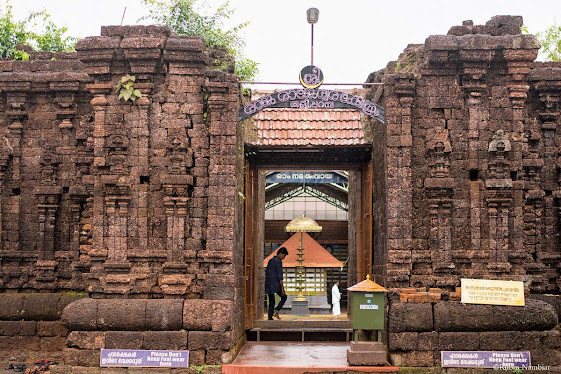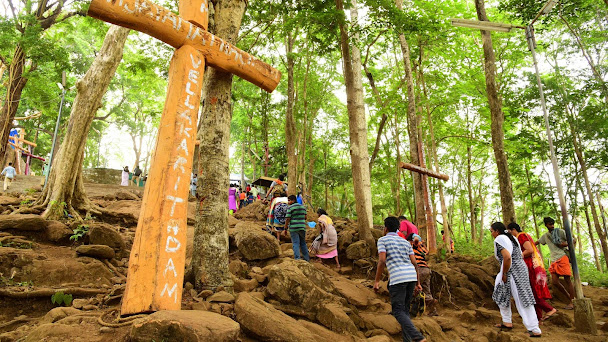The Legend of Rajarajeswara
The ancient temple is one of the existing 108 Shiva temples consecrated by Lord Parasurama & has the tallest Shikhara among any temples of its time. The temple as per legends was a simple temple with only the namaskara mandapam, but it was completed to its current form by the great King Raja Raja Cholan I in the early 11th century. There is no flagstaff which is an integral part of all the South Indian temples as the deity here is considered to be the emperor or Lord Supreme and is in the form of Sadashiva. The flagstaff or Kodimaram is part of the temple architecture to facilitate the people around to know whether there is a festival happening. At the Rajarajeswara temple, there is no such event as no annual festival is conducted here. Also, the deity is never taken out of the shrine which is done in most temples as a ceremonial affair. In most Shiva Temples, one will find the dhara which is said to keep the Lord calm at all times but here no such ritual is performed as here the Lord is in his most transcendental form.
No devotee is allowed to enter the namaskara mandapam in front of the Sanctum as it is believed to have the presence of Lord Rama who stopped here to pray on the way back to Ayodhya after his victory in war against Ravana. The transcendental form of the Lord is also considered quite auspicious for the wellbeing of young children & pregnant women flock to the temple to pray for the betterment of their unborn child. The temple also earns its distinction of importance for being the place where the traditional astrological decision of Prasna is conducted whenever there is a problem encountered at any temples in South India. The auspicious ceremony is conducted on a raised platform & has been followed here for many ages. The jyotirlinga found here is said to have been installed by Sage Agastya. The Lingam is said to be several thousand years old & has a legend behind its appearance. Shanaka & the other sons of Brahma churned the discs of sun to reduce its heat & with the dust that emanated from this Lord Shiva created 3 jyotirlingas which he gave to Goddess Parvathy. In the Treta Yuga, Sage Mandhata prayed to Lord Shiva & happy with his penance told Goddess Parvathy to present him one of the Jyotirlingas. He asked Mandhata to place the lingam in a place which had never seen death of any creature or never had any dead body fallen on it. The sage kept looking for such a place & finally came to the present place of the temple which was a land not bigger than a plate or Thalam. The sage placed the lingam here & worshipped here. The place over time came to be known as Thalaparambu which is now called Thaliparambu. At the end of Treta Yuga, the lingam disappeared from the place as it sank into the earth. Post the Treta Yuga, Muchukundan who was son of Mandhata again conducted penance to acquired the second lingam from Goddess Parvathy which he placed in the same place as the earlier lingam. Over the ages this lingam too disappeared from the place. King Shathasoman prayed to Lord Shiva & acquired the third lingam which he placed in the same place as the other two. He was worried that this lingam will also end with the same fate & to keep it permanently here asked Agastya Muni for help. Sage Agastya prayed to Lord Shiva & prostrated before him 12 times, as he started for the 13th Lord Shiva came to him & fixed the lingam permanently here. To this date it is considered to perform 12 & 1/2 namaskar at the sanctum as a ritual. The temple went into ruins & it was Lord Parasurama who with the help of the divine architect of Gods, Vishwakarma who constructed the earliest temple. After the temple was built, Sage Agastya came & lit a ghee lamp which is still lighted at all times.
The temple is also known for its unique custom of allowing women only in the evenings. Though men are allowed to enter at all times, the women devotees are allowed to enter the temple only after the Athazhapooja ritual ends. The reason for this unique ritual is part of a legend which believes that Lord Shiva is in the company of his consort Goddess Parvathy, sons Ganesha & Subramanyan. It is after sunset that Lord Shiva appears in the form of a Grihasth from the usual Hermit form. He is seen to be in the most pleased & gracious disposition which is when women can enter & worship as a divine couple. The only exception made to this ritual is during Shivratri celebration when women can enter the Sanctum even during the day. Another unique part of the temple is the presence of Mahalakshmi inside a closed door. The legend for this has a unique story attached with it. Lord Mahalakshmi came to the temple to pay obeisance to Rajarajeswara. Lord Shiva wanted the goddess to bestow all the prosperity to the temple but could not ask for it, so he assumed the form of Lord Vishnu. Goddess Mahalakshmi on seeing her Lord sat next to him on the seat of Goddess Parvathy. Lord Shiva assumed his own form & realizing her mistake Goddess Mahalakshmi hurried to exit the gate when the Bhootaganas or servants of Lord Shiva closed the door. When Lord Vishnu came looking for his consort, the Bhutaganas pleaded with him to allow Mahalakshmi to stay in the temple for which Lord Vishnu obliged. Thus the door on the west side of the Nalambalam at the temple is permanently kept shut to not allow Mahalakshmi leave the temple & thus keeping the prosperity for ever.
This temple apart from its reverence as a divine place is also considered to be a sacred place for the performance of ChakiarKoothu & Koodiyattam. The greatest appreciation for an artist or scholar - Veera Sringala or Golden Bracelet is awarded by a prominent scholarly body of the temple. The temple architecture has a two tier pyramidal structure which has stood the times. Most parts of the temple were destroyed during the invasion of Tipu Sultan. The Muslims around the temple fought the Mysore army & defended the temple. The temple of Rajarajeswara has been blessing its devotees for centuries and its divinity still reflects the ancient ways of life.




Comments
Post a Comment